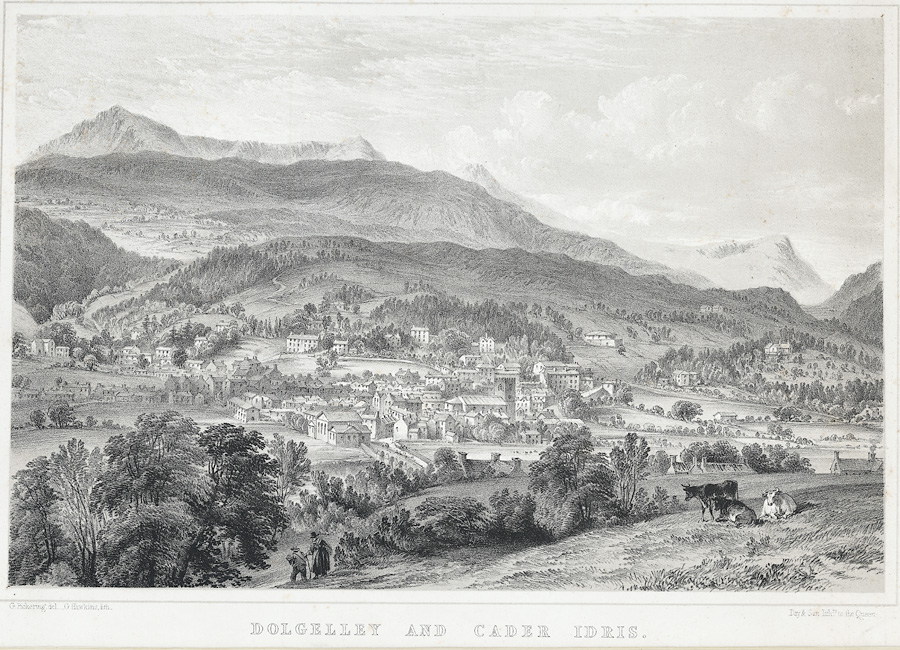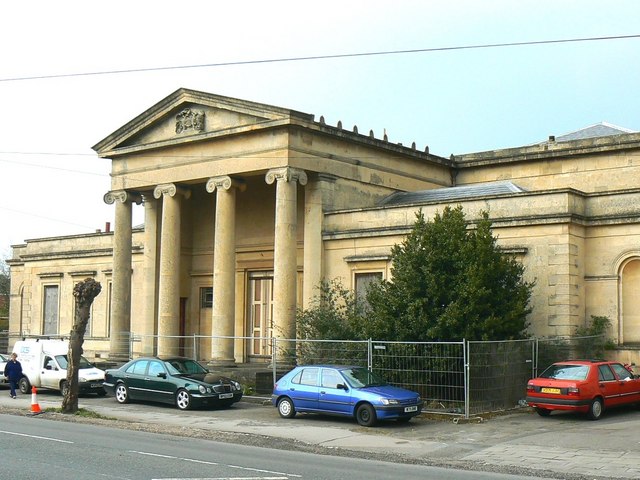|
County Hall, Dolgellau
County Hall ( cy, Neuadd y Sir Dolgellau) is a municipal building in Smithfield Street, Dolgellau, Gwynedd, Wales. The structure, which was the headquarters of Merionethshire County Council, is a Grade II* listed building. History The first county building in the town was the old courthouse ( cy, Y Sospan) in Queen's Square which was built in rubble masonry and completed in 1606. However, by the early 19th century the justices decided it was too small and sought a more substantial structure. The building in Smithfield Street was designed by Edward Haycock in the neoclassical style, built in ashlar stone at a cost of £3,000 and was completed in 1825. The design involved a symmetrical main frontage with five bays facing onto Smithfield Street with the end bays shorter than the central section and projected forward; the central section of three bays was fenestrated by three large segmental windows flanked by Tuscan order pilasters, while the end bays contained arched opening ... [...More Info...] [...Related Items...] OR: [Wikipedia] [Google] [Baidu] |
Dolgellau
Dolgellau () is a town and community in Gwynedd, north-west Wales, lying on the River Wnion, a tributary of the River Mawddach. It was the traditional county town of the historic county of Merionethshire ( cy, Meirionnydd, Sir Feirionnydd) until the county of Gwynedd was created in 1974. Dolgellau is the main base for climbers of Cadair Idris and Mynydd Moel which are visible from the town. Dolgellau is the second largest settlement in southern Gwynedd after Tywyn and includes the community of Penmaenpool. Etymology The name of the town is of uncertain origin, although ' is Welsh for "meadow" or "dale", and ' (soft mutation of ') means "grove" or "spinney", and is common locally in names for farms in sheltered nooks. This would seem to be the most likely derivation, giving the translation "Grove Meadow". It has also been suggested that the name could derive from the word ', meaning "cell", translating therefore as "Meadow of onks'cells", but this seems less likely considering ... [...More Info...] [...Related Items...] OR: [Wikipedia] [Google] [Baidu] |
Pilaster
In classical architecture Classical architecture usually denotes architecture which is more or less consciously derived from the principles of Greek and Roman architecture of classical antiquity, or sometimes even more specifically, from the works of the Roman architect V ..., a pilaster is an :Architectural elements, architectural element used to give the appearance of a supporting column and to articulate an extent of wall, with only an ornamental function. It consists of a flat surface raised from the main wall surface, usually treated as though it were a column, with a Capital (architecture), capital at the top, plinth (base) at the bottom, and the various other column elements. In contrast to a pilaster, an engaged column or buttress can support the structure of a wall and roof above. In human anatomy, a pilaster is a ridge that extends vertically across the femur, which is unique to modern humans. Its structural function is unclear. Definition In discussing Leon Battis ... [...More Info...] [...Related Items...] OR: [Wikipedia] [Google] [Baidu] |
Grade II* Listed Buildings In Gwynedd
In the United Kingdom, the term listed building refers to a building or other structure officially designated as being of special architectural, historical, or cultural significance; Grade II* structures are those considered to be "particularly important buildings of more than special interest". Listing was begun by a provision in the Town and Country Planning Act 1947. Once listed, strict limitations are imposed on the modifications allowed to a building's structure or fittings. In Wales, the authority for listing under the Planning (Listed Buildings and Conservation Areas) Act 1990 rests with Cadw. Buildings Notes See also * Grade I listed buildings in Gwynedd In the United Kingdom, the term listed building refers to a building or other structure o ... [...More Info...] [...Related Items...] OR: [Wikipedia] [Google] [Baidu] |
Caernarfon Criminal Justice Centre
The Caernarfon Criminal Justice Centre is a Crown Court venue, which deals with criminal cases, in Llanberis Road, Caernarfon, Wales. History Until the early 21st century, criminal court hearings in Caernarfon were held in the County Hall at Castle Ditch. However, as the number of court cases in Caernarfon grew, it became necessary to commission a more modern courthouse for criminal matters: the site selected in Llanberis Road had been occupied by Segontium School, which had dated from 1912 but which had closed in 2005. Work on the new building started in May 2007, when the Lord Chancellor, Lord Falconer, cut the first sod. It was designed by Austin-Smith:Lord in the Modernist style, built by Balfour Beatty in dark blue and red brick at a cost of £12 million and was completed in May 2009. The design involved an asymmetrical main frontage facing onto Llanberis Road. The plan involved two wings, one intended for the offices and the other for the courtrooms. The left hand sect ... [...More Info...] [...Related Items...] OR: [Wikipedia] [Google] [Baidu] |
Magistrates' Court
A magistrates' court is a lower court where, in several jurisdictions, all criminal proceedings start. Also some civil matters may be dealt with here, such as family proceedings. Courts * Magistrates' court (England and Wales) * Magistrate's Court of Jersey * Magistrates' court (Hong Kong) * Magistrate's courts of Israel * Magistrate's court (South Africa) * District Court (New Zealand), replaced magistrate's courts in 1980 * District Court (Ireland), the main court of summary jurisdiction in Ireland * Magistrate's court (Russia) * Magistrate's court (Sri Lanka) Australian courts * Magistrates Court of the Australian Capital Territory * Magistrates court (Northern Territory) * Magistrates Court of Queensland * Magistrates Court of South Australia * Magistrates Court of Tasmania * Magistrates' Court of Victoria * Magistrates Court of Western Australia * Local Court of New South Wales * Federal Circuit Court of Australia (initially the Federal Magistrate's Court of Australia. T ... [...More Info...] [...Related Items...] OR: [Wikipedia] [Google] [Baidu] |
Local Government Act 1888
Local may refer to: Geography and transportation * Local (train), a train serving local traffic demand * Local, Missouri, a community in the United States * Local government, a form of public administration, usually the lowest tier of administration * Local news, coverage of events in a local context which would not normally be of interest to those of other localities * Local union, a locally based trade union organization which forms part of a larger union Arts, entertainment, and media * ''Local'' (comics), a limited series comic book by Brian Wood and Ryan Kelly * ''Local'' (novel), a 2001 novel by Jaideep Varma * Local TV LLC, an American television broadcasting company * Locast, a non-profit streaming service offering local, over-the-air television * ''The Local'' (film), a 2008 action-drama film * '' The Local'', English-language news websites in several European countries Computing * .local, a network address component * Local variable, a variable that is given loca ... [...More Info...] [...Related Items...] OR: [Wikipedia] [Google] [Baidu] |
Bala, Gwynedd
Bala ( cy, Y Bala) is a town and community in Gwynedd, Wales. Formerly an urban district, Bala lies in the historic county of Merionethshire, at the north end of Bala Lake ( cy, Llyn Tegid). According to the 2021 Census, Bala had a population of 1,999. 72.5 per cent of the population can speak Welsh. Toponym The Welsh word ''bala'' refers to the outflow of a lake. History The Tower of Bala ''(Welsh: Tomen y Bala)'' ( high by diameter) is a tumulus or "moat-hill", formerly thought to mark the site of a Roman camp. In the 18th century, the town was well known for the manufacture of flannel, stockings, gloves and hosiery. The large stone-built theological college, ''Coleg y Bala'', of the Calvinistic Methodists and the grammar school (now Ysgol y Berwyn), which was founded in 1712, are the chief features, together with the statue of the Rev. Thomas Charles (1755–1814), the theological writer, to whom was largely due the foundation of the British and Foreign Bible Socie ... [...More Info...] [...Related Items...] OR: [Wikipedia] [Google] [Baidu] |
Assizes
The courts of assize, or assizes (), were periodic courts held around England and Wales until 1972, when together with the quarter sessions they were abolished by the Courts Act 1971 and replaced by a single permanent Crown Court. The assizes exercised both civil and criminal jurisdiction, though most of their work was on the criminal side. The assizes heard the most serious cases, which were committed to it by the quarter sessions (local county courts held four times per year), while the more minor offences were dealt with summarily by justices of the peace in petty sessions (also known as magistrates' courts). The word ''assize'' refers to the sittings or sessions (Old French ''assises'') of the judges, known as "justices of assize", who were judges who travelled across the seven circuits of England and Wales on commissions of "oyer and terminer", setting up court and summoning juries at the various assize towns. Etymology Middle English < |
Pediment
Pediments are gables, usually of a triangular shape. Pediments are placed above the horizontal structure of the lintel, or entablature, if supported by columns. Pediments can contain an overdoor and are usually topped by hood moulds. A pediment is sometimes the top element of a portico. For symmetric designs, it provides a center point and is often used to add grandness to entrances. The tympanum, the triangular area within the pediment, is often decorated with a pedimental sculpture which may be freestanding or a relief sculpture. The tympanum may hold an inscription, or in modern times, a clock face. Pediments are found in ancient Greek architecture as early as 600 BC (e.g. the archaic Temple of Artemis). Variations of the pediment occur in later architectural styles such as Classical, Neoclassical and Baroque. Gable roofs were common in ancient Greek temples with a low pitch (angle of 12.5° to 16°). History The pediment is found in classical Greek temples, Et ... [...More Info...] [...Related Items...] OR: [Wikipedia] [Google] [Baidu] |
Modillion
A modillion is an ornate bracket, more horizontal in shape and less imposing than a corbel. They are often seen underneath a cornice which it helps to support. Modillions are more elaborate than dentils (literally translated as small teeth). All three are selectively used as adjectival historic past participles (''corbelled, modillioned, dentillated'') as to what co-supports or simply adorns any high structure of a building, such as a terrace of a roof (flat area of a roof), parapet, pediment/entablature, balcony, cornice band or roof cornice. Modillions occur classically under a Corinthian or a Composite cornice, but may support any type of eaves cornice. They may be carved or plain. See also * Glossary of architecture Gallery Abbaye Ste Foy à Conques (25) - Frises et corbeaux du chevet.jpg, Modillions carved with animal heads in the Abbaye Ste Foy in Conques (France). 20130809 dublin036.JPG, Trinity College, in Dublin. Disegno di Modiglione (mensola, chiave di volta) a dopp ... [...More Info...] [...Related Items...] OR: [Wikipedia] [Google] [Baidu] |
Wrought Iron
Wrought iron is an iron alloy with a very low carbon content (less than 0.08%) in contrast to that of cast iron (2.1% to 4%). It is a semi-fused mass of iron with fibrous slag Inclusion (mineral), inclusions (up to 2% by weight), which give it a wood-like "grain" that is visible when it is etched, rusted, or bent to structural failure, failure. Wrought iron is tough, malleable, ductile, corrosion resistant, and easily forge welding, forge welded, but is more difficult to welding, weld electrically. Before the development of effective methods of steelmaking and the availability of large quantities of steel, wrought iron was the most common form of malleable iron. It was given the name ''wrought'' because it was hammered, rolled, or otherwise worked while hot enough to expel molten slag. The modern functional equivalent of wrought iron is Carbon steel#Mild or low-carbon steel, mild steel, also called low-carbon steel. Neither wrought iron nor mild steel contain enough carbon to be ... [...More Info...] [...Related Items...] OR: [Wikipedia] [Google] [Baidu] |
Tuscan Order
The Tuscan order (Latin ''Ordo Tuscanicus'' or ''Ordo Tuscanus'', with the meaning of Etruscan order) is one of the two classical orders developed by the Romans, the other being the composite order. It is influenced by the Doric order, but with un-fluted columns and a simpler entablature with no triglyphs or guttae. While relatively simple columns with round capitals had been part of the vernacular architecture of Italy and much of Europe since at least Etruscan architecture, the Romans did not consider this style to be a distinct architectural order (for example, the Roman architect Vitruvius did not include it alongside his descriptions of the Greek Doric, Ionic, and Corinthian orders). Its classification as a separate formal order is first mentioned in Isidore of Seville's ''Etymologies'' and refined during the Italian Renaissance. Sebastiano Serlio described five orders including a "Tuscan order", "the solidest and least ornate", in his fourth book of ''Regole generali di ... [...More Info...] [...Related Items...] OR: [Wikipedia] [Google] [Baidu] |







